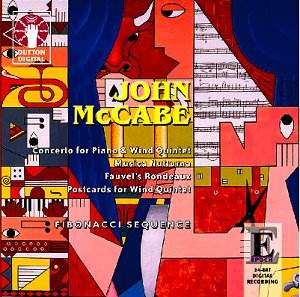This disc brings together some of John McCabe’s
finest chamber works in commanding performances marrying sensitivity
with technical virtuosity. The earliest item on the programme
is the Musica Notturna for violin, viola and piano, which was
written in 1964 for Martin Milner, who had premiered the composer’s
Baxian First Violin Concerto of 1959. As in some of the composer’s
most characteristic works, this is in one continuous movement
made up of a number of distinctly outlined sections. A slowly
evolving, atmospheric opening section returns at the end to round
off the work. This opening material is treated as a theme providing
a source of variations in the form of melodic and harmonic transformations.
Two quick, rhythmic sections enclose a central passacaglia of
latent power. The first Allegro contains echoes of the second
subject of the Finale of Shostakovich’s Second Piano Concerto
(Track 6: 4’ 17’’ – 4’ 35’’) and the spirit of the Russian master
hovers over the second Allegro passage too, though it may be going
too far to point out the famous D-S-C-H motto theme among the
work’s semitonal figures. It makes for a deeply satisfying work
dating from the time of McCabe’s orchestral ‘Hartmann Variations’
and conveying a similar impression of a distinctive voice emerging
in British music.
The Concerto for Piano and Wind Quintet dates
from 1969 and is dedicated to Alun Hoddinott and his wife. It
is another piece in one continuous movement with several sections
joined together, this time by means of two related mini-cadenzas,
one for horn, the second for clarinet. The central Vivo section
is initiated by a flutter-tongued flute figure redolent of Britten’s
Sinfonia da Requiem; it turns up again in the central section
of McCabe’s Concerto for Orchestra of 1982. A virtuoso piece,
especially for the pianist, this concerto is small scale only
in terms of the forces required – technically and emotionally,
it is on the grandest scale.
The remaining pieces, Fauvel’s Rondeaux (1996)
and Postcards for Wind Quintet (a 1991 reworking of a set of bagatelles
dating from 1965) are also welcome additions to the McCabe discography.
The former work contains the most demanding writing on the programme,
culled as it is from some of the most darkly potent music from
the composer’s very fine Edward II ballet music, whilst the Postcards
usefully encapsulate different facets of McCabe’s style from jazz
and fugue to the nocturne.
The Fibonacci Sequence play with great understanding
and character in these rewarding works and the recording is clean
and well balanced. I look forward to more McCabe on Dutton from
these players in the future – there are a number of early works
in the composer’s output which I am sure would reward investigation
such as the Partita for String Quartet (1960), Three Pieces for
Clarinet and Piano (1964), String Trio (1965), Nocturnal for Piano
Quintet (1966), the Oboe Quartet (1968) and the Sonata for Clarinet,
Cello and Piano of 1969. In the meantime, this release is warmly
recommended.
Paul Conway
